







A time of change is upon us, like none we have seen for generations. A time of vulnerability, but also opportunity too. In this episode of Visual Friends Radio, we’re joined by Marcel van Hove and Danny Low of the Visual Friends team to talk about how they’re focusing on adaptability, innovation and channelling their creative power during the current pandemic.

Over a decade ago Charity watched a team of consultants at an offsite event create awe-inspiring visual content. She dreamed that one day she too could communicate with simple visuals from words but had no idea how to get there. Flash forward 10 years to discovering Visual Friends, bikablo and her journey has begun.
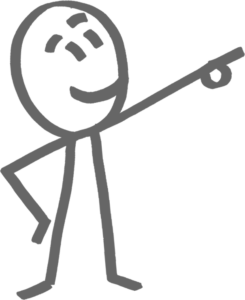

Primary school teacher and now a part-time graphic scribe
![]() Anyone can learn visualisation. Once you learn basic icons, fill your page and get a grasp on shading, the world is your oyster.
Anyone can learn visualisation. Once you learn basic icons, fill your page and get a grasp on shading, the world is your oyster.
Matt loves his work. “I’ve always been creative and being a primary school teacher provides a creative outlet.”
Now that Matt knows bikablo®, his work has become even more interesting. And not just for Matt but also for his colleagues.
Like many of our students, Matt saw bikablo® in action when someone was scribing at a meeting. Matt always enjoyed taking notes, but this seemed to be next level. Curious, he began researching visualisation skills and came across Visual Friends.
“I saw what people can do, it’s quite inspiring. I thought it would be great to take my knowledge to the next level.”
With the support of his principal, who understood the great benefit of bringing such applicable skill to the school, Matt enrolled in bikablo® fundamentals training.
Teachers can be fussy students, but he found the course really useful. “It was hands on from the word go which is the best way to learn. I learnt to use the space in a smart way and it gave me confidence to work through a page.”
As a teacher, Matt also appreciated the research behind visualisation. “It engages all areas of a learner.” What also appealed was how easy it was to learn this skill and how much you could achieve once you understood the basic principles.
“It’s not that complicated. Once you learn basic icons, fill your page and get a grasp on shading, the world is your oyster. You can then go on and develop your own style.”
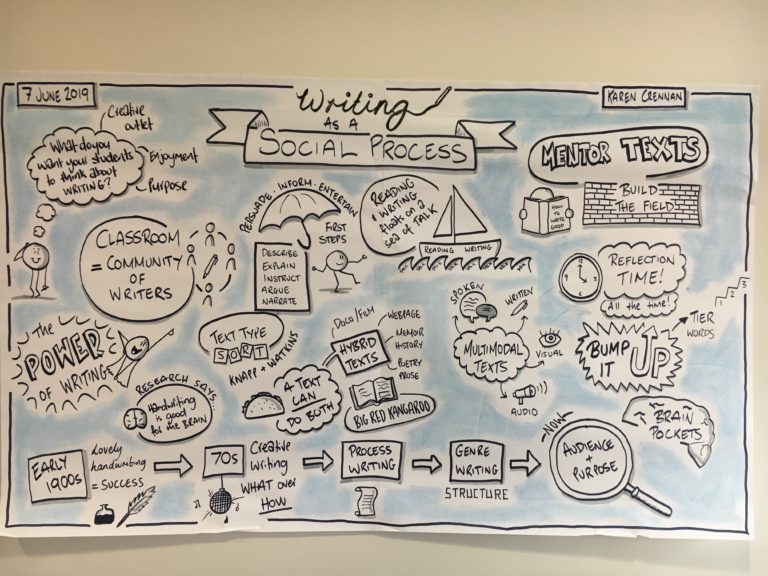
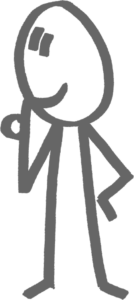
Writing as a Social Process
Matt Handley
Matt feels that’s an important part of learning visualisation or any other subject for that matter – to build on your skills and develop your way of doing things.
“I think the key is to be flexible and just draw things that stand out to you. It’s about making it your own, whether it’s using your own font or your favourite picture. It doesn’t have to be perfect. And of course, the more you practice, the better you get.”
That’s exactly what Matt has been doing.
Since completing the course, he has been giving back to his workplace, creating posters, helping with presentations and meetings. Matt’s three-meter canvas describing school’s self-improvement project journey was displayed at the school library and generated some interesting discussions.
“People have been looking at it and talking about it. Some say they wouldn’t be able to do something like that, but I assure them that with a bit of practice everyone can do it.”
Following his original interest, Matt also took his notetaking to the next level and tried live scribing at school events.
“It was stressful, but it also taught me to focus on the main points instead of trying to capture every word. Those key points are the ones that will trigger people’s memories and will facilitate the conversation.”
Matt is pleased with the feedback he’s received so far. “People comment on how easy it is to read and follow two hours worth of talking on one page.”

Journey of Learning – Matt Handley
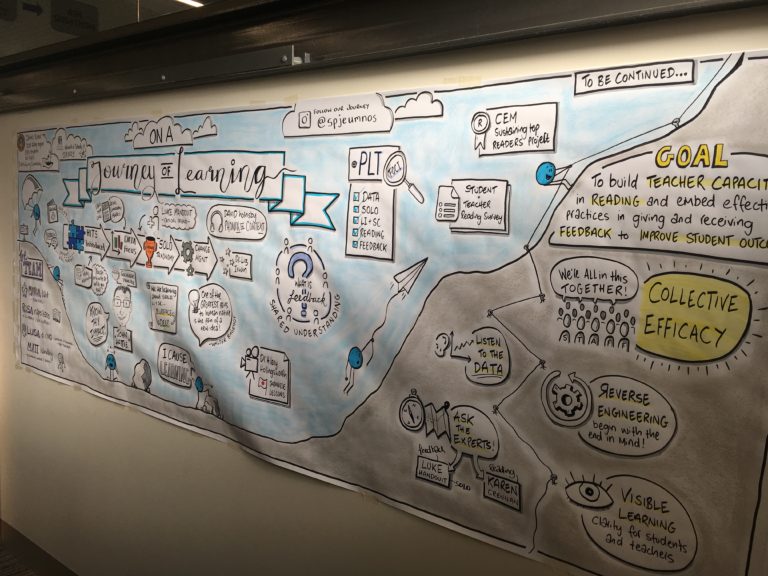
The skills Matt has leant with Visual Friends are definitely making a difference at his workplace. Visualisation is now seeping in the way the school does things.
“In terms of transcribing and professional development, it’s been more than beneficial for our staff and school. Our principal is pleased with how it has turned out.”
Matt is pretty happy too. He has developed a long-term interest in visualisation and added a unique skill to his toolbox that will have a positive effect on his career.
“It’s definitely something I see myself using in the future, wherever my career takes me. It’s a great tool you can share with others.”
P.S. Since we’ve interviewed Matt, he has started his own business working as a graphic scribe in his spare time. You can find him on instagram @_highlyvisual.
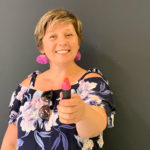
The article was written by Natalia Tsygankova. Natalia has always loved words and talking to people. She has put that passion to good use and has been sharing people’s stories in the community radio, TV and print media for the last 10 years. Natalia is also a big fan of true storytelling events and regularly volunteers at the most famous one – The Moth, interviewing the winner. You can hear her own story of moving to Australia from Russia in 1999 here. Natalia believes that everyone has a story – So what’s yours? Contact her today to share your story.



Graphic Recorder Strategic Visualiser, Award-winning Cartoonist, Writer and Animator.
I met Sarah Firth when I moved to Australia the second time in 2013. Sarah was for me THE graphic recorder, and I admired and still admire the great art she creates. Sarah is an award-winning comic artist, graphic recorder, writer and animator based in Melbourne.
In this fascinating episode of Visual Friends podcast, we learn about how she grew up in Canberra and later travelled the world. We hear about sketchnoting and how it helped Sarah focus at school. How she started her a career as an artist and how she got into graphic recording around 2010. She shares an incredible story about a major accident she’d been in and how sketchnoting helped her reconnect with her life while she was in the hospital.
Today, Sarah uses her skills in very challenging environments. She likes to work for non-for profit organisations, for example, helping people overcome trauma.
Sarah shares some tips about how you can improve your drawing skills over the years to become a rockstar in the field of graphic recording.
With that, please enjoy the episode and we look forward to welcoming you in person at VizConf on the 19th of October 2019 where we are privileged to have Sarah as one of our keynote speakers.
Sarah Firth is an award-winning comic artist and writer based in Melbourne. Since 2011, she has run a successful small business, offering graphic recording and facilitation, animation and event design. With the mission to help clients clarify, align, resolve, connect and communicate – through powerful visual modelling, storytelling and strategic mapping.
Sarah works across industries and sectors, with a particular interest in supporting clients navigating wicked problems, systemic change and high levels of complexity, environmental justice and social impact.
She has worked locally and internationally on projects and events with; Vienna Complexity Science Hub, Google, The Rockefeller Foundation, CSIRO, The Red Cross, Conservation Zoos Victoria, Melbourne Faculty of Business & Economics, Comedy Central, Environmental Justice Australia, SIEMENS, Vienna Complexity Science Hub, Not For Profit Law, ACMI, Aboriginal Victoria, KPMG, Pricewaterhouse Coopers, Planning Institute of Australia, Ernst & Young, City of Melbourne, Victorian Department of Premier and Cabinet, Oxfam, PLAN International and many more.
Alongside her business Sarah maintains a professional art and writing practice. Some notable achievements have been; receiving the Talking Difference Fellowship with the Immigration Museum, being named one of Australia’s top 25 artists by Art & Australia Magazine, winning The People’s Choice Award in the Australian Shorts section of the Human Rights Arts and Film Festival, performing at the Yogyakarta Biennale in Indonesia, the Lakes International Comic Festival in the UK, and the Ubud Writers and Readers Festival.
Most recently, she was appointed deputy chair on the board of directors for the Cultural Development Network, she received a Frankie Magazine Good Stuff Award, was a finalist in the Incinerator Social Change Art Award, and her graphic essay on complexity was listed in The Conversation’s ten best literary comics in Australia.
Sarah has a new illustrated book Badass Mums out now with Affirm Press, along with comics in upcoming publications with Allen & Unwin, Abrams Books and Picador Australia. She is currently working on her debut graphic novel thanks to the support of the Creators Fund.
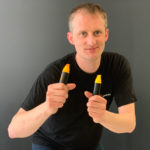
Marcel combines agile team coaching with visual thinking. Marcel believes that a group of people drawing together on a whiteboard can change the world. He loves high-performing teams and therefore coaches teams every day.


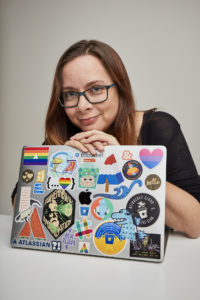
Content Designer Manager | Writer | Technical Communicator at an Australian Global Organisation, Leader in IT Service Desk and Project Management Software
![]() I’m so thankful I have come along to the Visual Friends course, it has really shifted and changed things for me.
I’m so thankful I have come along to the Visual Friends course, it has really shifted and changed things for me.
A hug was not something Linette would have expected going into that meeting. After all, all she did was draw.
But that’s exactly what happened. The team manager was so thrilled at the breakthrough Linette created through her visuals, that she leaped across the room and gave her a big hug.
The product development team of 25 had been working on the project for nine months. There was a lot of conceptual and abstract data that was difficult to wrap up into a neat, mutually exclusive and collectively exhaustive process they were trying to create. The team was stuck. Linette visualised all the elements on paper and immediately everything became clear. Her visuals became the key that unlocked the project puzzle.
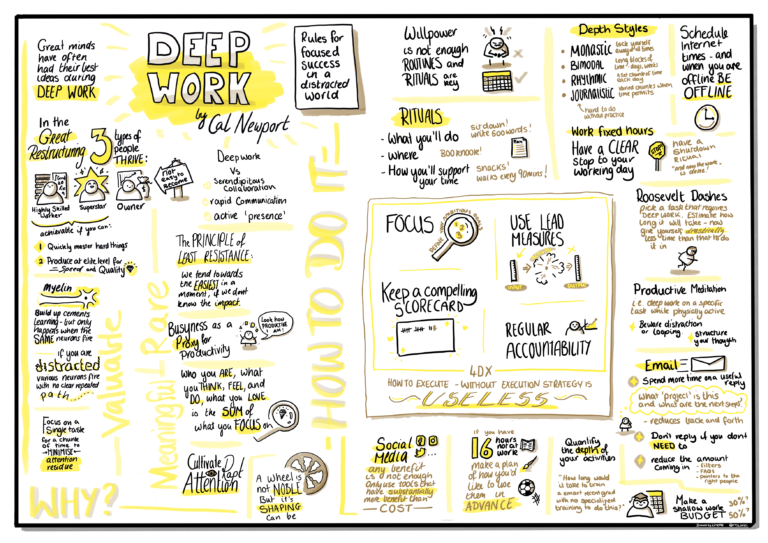

Deep work
by Cal Newport
Funnily enough, Linette never considered herself visual. “I was interested in art and did a bit at school as an elective. But I was discouraged from pursuing it. There was very much a feeling that anything visual was only for people who couldn’t do science. Science was more important.”
After school Linette completed a degree in Industrial Design which further cemented her belief that drawing was not her strength. “Other students were doing these brilliant sketches and my little stick figure next to their 3D rendering would look awful. That confirmed in my mind that I didn’t have great visual skills.”
So for years the only drawing Linette did was doodling while talking on the phone. Until she heard a colleague, Ben Crothers, the author of “Presto Sketching”, give a talk about sketchnoting.
“Wow! I wish I could learn that skill, “ thought Linette. She had seen visual facilitators doing this work and thought it was amazing. A colleague mentioned bikablo. “And I thought, what on Earth does bikablo mean? What is this?”.
A few people recommended the course as a great starting point in the area of visualisation, something really useful, and Linette was in. She persuaded her manager to send her on a course, “but I was wondering, actually, how and if I’d be able to apply it in my day to day life and work.”
Linette did the two-day bikablo fundamentals course in March, 2019 with Danny Low and Marc Hundleby.

Content Design
with Sarah Richard
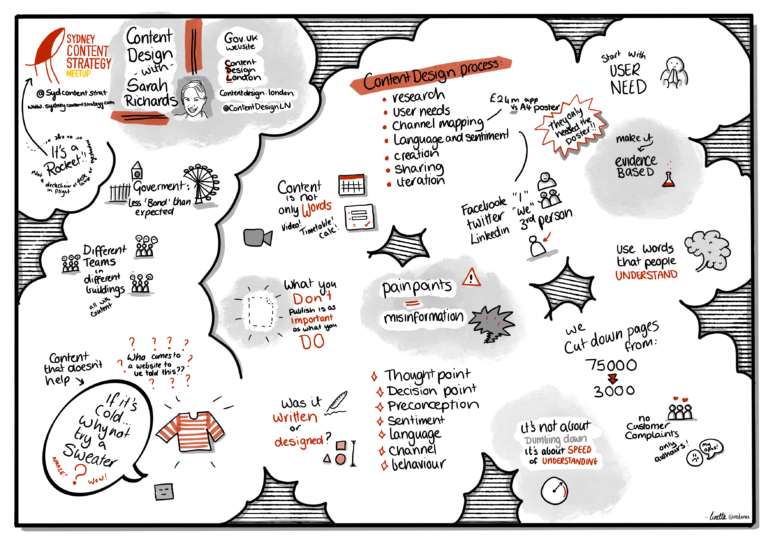
“I found the experience excellent. It was reassuring to see other people in the room saying, “Well, I’m not good at drawing, I find stick figures challenging. It made me feel very safe.”
The step-by-step process allowed Linette to tackle one mini skill at a time without sliding into the familiar mindset of “I can’t draw.”“Going through the steps, each time I thought, yes, I can do this and yes, I can do that too.It was challenging to put up our creations on the walls and, at first, I was scared that my work would be the worst. But I was delighted to see that we all did different things, we interpreted things differently and absolutely everyone had something really impressive. It was amazing to see the skill developing around the room.”
Back at work, initially Linette was apprehensive to use the skills she’d just learnt. She began practising by taking visual notes during meetings without showing it to anyone. Once, at a strategy meeting, she decided to share her visuals with the team, quite pleased with what she had sketched.
“The manager looked and said, “Wow! They are fantastic”, shared them with the product leadership team, got the same excited response and my drawings were published on the strategy internal webpage, for everyone in my area to see. I did have to run away and tidy it up a bit, because it was sketched on lined paper without proper markers.”
From then on, Linette became known as the visual person at work. “People would ask me, “Oh, we are trying to get this idea across, can you draw a thing?” She also began to regularly take visual notes during monthly strategy meetings and they were always very well received. “I feel it’s certainly because of these visuals that people higher up in the organisation knew a bit more about who I was, people who otherwise might have not met me or interacted with me.”
And that’s how Linette ended up in the meeting that we started our story with. “Essentially, all I did was listen to the team and sketched what they were saying. They had all the information but the challenge was communicating all that complex conceptual data visually.”
Unfortunately we can’t share the drawings or the details of the project here, but we can say that thanks to Linette’s drawings helped communicate the process to a lot of people. In addition, visualisation, as a part of the process, was recommended to the next team that was working on a similar project.
Since then Linette has done a few other things. Visual Friends training gave her the courage to enrol and complete a nature illustration course. Practising visualisation by creating visual summaries of non-fiction books led to her being approached by a publisher who saw one such drawing on instagram. It is now going to be used as an illustration in a future book. Linette is also mastering the Apple Pencil and virtual scribing. Her morning ritual during the covid-19 isolation is drawing virtual zoom backgrounds.

Unf*ck your boundaries
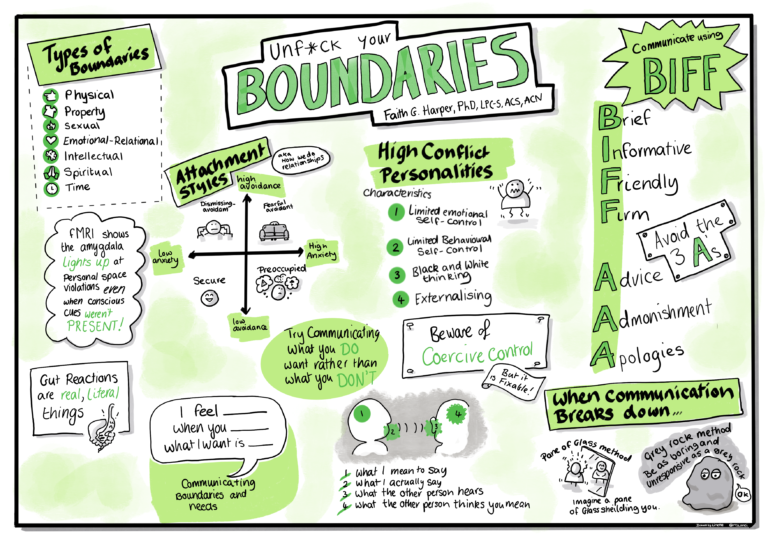
I found that training with Visual Friends helped me unlock my creativity. I genuinely think that I would not have had the confidence to do all that, had it not been for doing the bikablo course.” But the highlight so far is still that first strategy meeting, when Linette’s notes were used as a visual for the whole product strategy.
“Even now people refer back to that illustration to explain our focus and goals. That was the moment when I switched from feeling like my notes were a creative ‘indulgence’ to seeing how much they could help others.
I”m so thankful I have come along to the Visual Friends course, it has really shifted and changed things for me.”
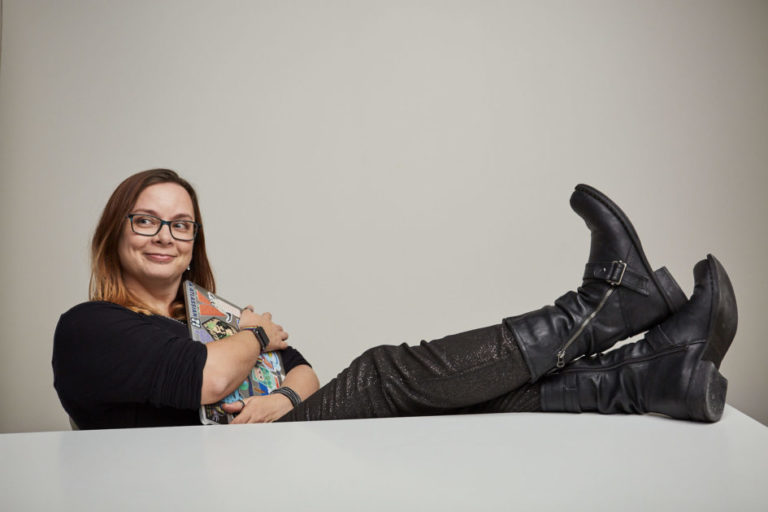


The article was written by Natalia Tsygankova. Natalia has always loved words and talking to people. She has put that passion to good use and has been sharing people’s stories in the community radio, TV and print media for the last 10 years. Natalia is also a big fan of true storytelling events and regularly volunteers at the most famous one – The Moth, interviewing the winner. You can hear her own story of moving to Australia from Russia in 1999 here. Natalia believes that everyone has a story – So what’s yours? Contact her today to share your story.


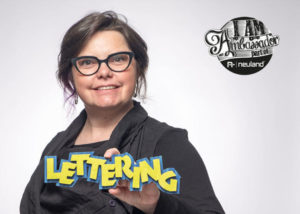
Founder of Let's Letter Together!
A couple of words about Heather Martinez. Heather likes to live in the mountain valley of Durango, Colorado. Heather is a visual practitioner and also an ‘Agile guy’ like me or Danny. She spends a lot of her time running virtual lettering classes for visual practitioners on LetsLetterTogether.com where you can improve your lettering skills on a 1:1 based via Zoom. Additionally, she will be offering 2 online courses associated with her new book and a virtual version of her in-person workshop: Level Up Your Lettering starting in the spring. In parallel, she runs her coaching practice where she offers life and art life coaching to artists. Here Heather believes that everyone can become an artist!
We talk about her whole life from the beginning where she grew up, where she chose to live and how she got into graphic facilitation. We learn how it feels being graphically recorded for the first time herself and what we as graphic recorders might need to consider when recording someone talk.
Last but not least, we talk about her new book which will have the title the ‘Lettering Journey’. It’s based on a cross-country road trip she took after leaving Washington, DC. She has a great plan for how she will create her next book: She travels and teaches lettering across Europe over the next 2 months. While all of her workshops have filled, she will offer an additional 1-day Lettering tour in each city. She will take the participants out of the training room into the environment, walk the streets and look for lettering styles they can break down and use in their work at the wall. The “tradecraft” of lettering will be covered, including how to find inspiration in your environment and how to break down each style into the strokes and tools used. Please have a look at her travel schedule here:
Lettering Tours:
Other locations may include:
Other upcoming workshops:
Now you might think Europe is far away and I can’t travel right now! – Here we are delighted that Heather has confirmed to be our keynote speaker for VizConf 2019. Additionally, she will also run a pre-conference course about lettering the day before VizConf and might even take everyone on a lettering tour through Melbourne.
Stay tuned and make sure you get your Visual Friends newsletter updates so that you don’t miss the spot in her class.

Marcel combines agile team coaching with visual thinking. Marcel believes that a group of people drawing together on a whiteboard can change the world. He loves high-performing teams and therefore coaches teams every day.


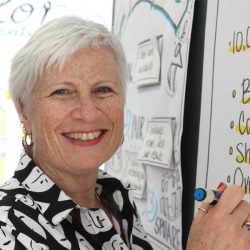
Founder of POINTS OF YOU®
Imagine the following: In order to make the most of the opportunity to attend a visual practitioner conference for the first time – you write a book, bring it along and sell it there. This might sound a bit crazy but this is exactly what Jill Greenbaum did when she attended her first IFVP conference in Pittsburgh in 2012 and it has worked out quite well as Jill is selling her book “How to Major in You and Find the Right College” ever since.
But of course, Jill didn’t write a book out of the blue. She looks back on a great career in the field of education. She has studied Psychology and Education at Clark University before she became a teacher, principal and administrator in various settings in New York City. Jill ran two non-for-profit programs before she started working for herself in 1996.
We talk about her coaching practice and her work as a facilitator with POINTS OF YOU® from Israel who provides inspiring life coaching cards that you can use for live coaching games. Last but not least we look at her upcoming bikablo® training in the US that she hosts, her work on the IFVP board and learn that she even has been to Tasmania recently!

Marcel combines agile team coaching with visual thinking. Marcel believes that a group of people drawing together on a whiteboard can change the world. He loves high-performing teams and therefore coaches teams every day.


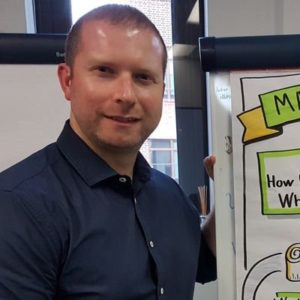
Agile Coach & Graphic Recorder
TLDR; Visual Friends Question & Answer – Use mindfulness and deliberate practice to uplift your visual capability.
The Visual Friends training team have been flat-out running bikablo® visual training over the last year. A segment of the training I really enjoy, is opening the question & answer space on the second day. We simply hang up a poster with a big Question Mark and ask for Post-Its to fill the space. As trainers, we want to create a 2-way conversation over the topics and I enjoy sharing my experience as well as collecting insights from the room.
It’s time to share back and expand on some of the insights that resonated with me and the groups I have trained through a blog series. Let’s add to the co-created body of knowledge on visual facilitation and bikablo®.
![]() “How do I get better? How often should you practice to become good, how do you get faster at drawing?”
“How do I get better? How often should you practice to become good, how do you get faster at drawing?”
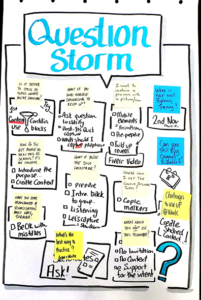

How can I improve?
Mindfulness & Deliberate Practice 1. I have moved towards a mindset change in how I practice drawing and visualisation. The mindset of “Practice Makes Permanent” resonates for me. In today’s world, perfect generally gets in the way of a faster, simpler outcome that still achieves the result. So following that mindset, here are the steps in a structured approach to being deliberate with practice which has helped me achieve goals.
Sir Richard Branson said “If somebody offers you an amazing opportunity but you are not sure you can do it, say yes – then learn how to do it later!”. Be open to learning and exploring new challenges. Changing your mindset about learning and practicing, will allow you to say YES more often and grow from those experiences.
Before starting a big visual project, I have often felt like I have ‘bitten off more than I could chew’. Sometimes I have felt challenged to the point of fear because the project required skills I simply didn’t have at that time. Some examples; “draw 6 communication posters in a weekend!”, “can you graphic record tomorrow at the conference?”, “let’s create a 5 minute sketch video on a complex strategy!”.
Initially, I had no idea on how to move forward. That feeling of fear, while true in your current context, is not helpful to achieving a goal.
I recently learnt about a framework to describe how we think and feel about situations – ‘above or below the line’. Being mindful of your emotional state in this situation is important. Reflect on what your body and mind are saying, what is true?, what may be an illusion?
There is a catchy acronym that I use in this situation, F.E.A.R; False Evidence Appearing Real. Identify that are those things that are really not true, but are physically influencing the way you see and feel in a situation. Once you have that understanding, move onto the next step, moving above the line towards a constructive mindset.
Think about breaking down your problem. What small step could you take, what bet could you take to get a different perspective or new information on the problem. Sit down with a pencil and paper in a quiet space and sketch out our idea. That will change your context to a place from where you can see the next step towards achieving your goal.
Ask someone for feedback, but hold the feedback lightly. See how that new perspective may also help guide you towards achieving the goal. Another reflection technique is to keep a journal. Share your visual on the Visual Friends LinkedIn group or on the Graphic Facilitation Facebook group.
By being focused and committed to improvement, you may surprise yourself with the outcomes you create. You focus on the differences that make a difference. Set a goal, keep your goal, practice often.
Challenge: People speak fast, there are 150 slides of content, I can’t keep up and I loose track of the narrative.
Goal: Improve active listening skills – improve content capture and organisation of information. Strengthen your response speed between listening, synthesizing and drawing. Capture less but focus on verb & noun combinations. Practice recognising the key themes and patterns coming through.
Challenge: I can’t remember the symbols when I draw and I can’t remember people!
Goal: Build Visual Dictionary – recall more symbols and shapes that improves the anchoring and aesthetic of your poster. The less you need to think about what to draw, the more you can focus on capturing the content of the dialogue – the most important part of visualisation.
How to focus when practicing? When you are at the wall, turn off mobile phone, take everything out of your hands and pockets, slow down, take a deep breath, remember lines are your friend, draw slow but deliberate. Really, really focus on the speaker. The outcome is you will get “into flow” faster and you can be 100% present to serve the group.
Creating opportunities in the workplace. Practicing visual facilitation in your place of work is ideal. Many different sources of content, different communication contexts. Offer to perform a visual recording of a team meeting, strategy session, all hands meeting or communication poster. Be humble and thankful of feedback. My steer here is to be strategic with what you say Yes to..
Go small Sketchnotes are possibly the best way to practice – in meetings, at presentations, visualise the conversation and share it.
Please get in touch, I’d like to hear your feedback on this article and your experiences in personal growth and working visually. hello@visualfriends.com. Stay tuned for the next instalment of Visual Q&A from Visual Friends.
ref 1: https://expertenough.com/2327/deliberate-practice-steps

The article was written by Natalia Tsygankova. Natalia has always loved words and talking to people. She has put that passion to good use and has been sharing people’s stories in the community radio, TV and print media for the last 10 years. Natalia is also a big fan of true storytelling events and regularly volunteers at the most famous one – The Moth, interviewing the winner. You can hear her own story of moving to Australia from Russia in 1999 here. Natalia believes that everyone has a story – So what’s yours? Contact her today to share your story.


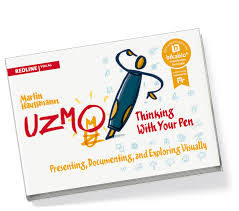
Presenting, Documenting and Exploring Visually
At the start of every bikablo® basics class, we talk about what bikablo is and how it is different. Most people who attend our classes have ‘no drawing skills’ and are worried about their lack of drawing ability. At the end of two days, they are consistently surprised with the dramatic change in their ability to visualise. The reason for these results is that bikablo is a systematic approach to visualisation. In bikablo, we say that ‘visualisation is not about art, it’s about language’. And just like any language, the goal is about communicating meaning. All languages do this because they have systematic grammar, syntax and cultural nuances that allow people to have shared understanding of what is being communicated. Just like the languages we speak in, bikablo is a systematic visual language. It has letters, words, grammar and syntax that can be combined and recombined in different ways in order to communicate content in a way that is meaningful to its audience and their surrounding context.
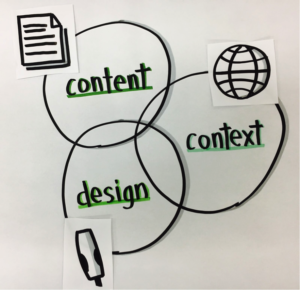

In his book, ‘UZMO’, bikablo co-founder Martin Haussmann provides a simple but very powerful framework for understanding, and using, visualisation as a language. It has three basic elements, that I like to represent as a Venn Diagram:
When I communicate this idea at the beginning of a class, it’s always greeted with a few nods and a few puzzled expressions. But as we gradually build in each layer of the technique and apply it in practice, I return to this framework as a way to plan and then execute our visualisations. Through this journey of theory and practical experience, the penny drops on what this framework means and how it can be used in practice. Let me give you a simple example of how I used this recently.
I was designing a 2-hr class on how to design and facilitate collaborative meetings and workshops. There would be 32 students who were coming after work and would be seated in a ‘cosy’ classroom for 2-hours. My presentation was largely based on a slide deck I had created but was organised around two frameworks that would gradually be revealed. The students would need to hold the frameworks in their mind as we progressed through the slide deck. I would need to be able to refer back to the frameworks throughout the class. I needed to create ‘signposts’ for each part of my content that would help the group remember the frameworks as I talked to them. I also needed people to be able to see the signposts from the back of the room.
Finally, this was a class that I planned to offer multiple times, so I needed re-usable content.
The 5 key jobs of a facilitator
The 5 key design elements of any collaboration session
Overall there were are two frameworks each with elements, so 10 content elements overall.

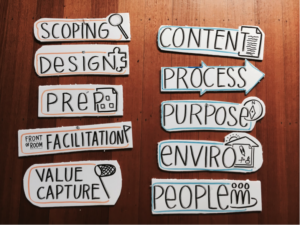
As you can see from the images, I created 10 physical signposts which we call ‘mobile elements’ in bikablo®. I used bold, visible lettering with an icon or container around each to anchor the meaning of each piece of content. I also used two different colours to delineate the two different frameworks. I used foam board (or foam core) for two reasons. Firstly because its smooth white surface really takes well to markers without bleeding. Secondly it is a light, stiff and relatively durable material which would last longer with repeated use.
This is a simple example, but the framework is scalable to larger, more complicated visualisations, and indeed, to any form of design work more generally that involves content that must be communicated in a way that can be interpreted in a way that fits a particular context.
Join us at one of our upcoming 2-day classes to learn more about this framework and how to use it in practice.

The article was written by Natalia Tsygankova. Natalia has always loved words and talking to people. She has put that passion to good use and has been sharing people’s stories in the community radio, TV and print media for the last 10 years. Natalia is also a big fan of true storytelling events and regularly volunteers at the most famous one – The Moth, interviewing the winner. You can hear her own story of moving to Australia from Russia in 1999 here. Natalia believes that everyone has a story – So what’s yours? Contact her today to share your story.


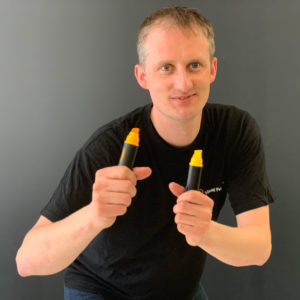
Co-Founder Visual Friends
To understand what bikablo® means we need to go back almost 10 years. When a company — actually a consultancy from Cologne stated their first product and this company was called, it’s still around, of course, Kommunikationslotsen, it’s quite hard to pronounce I know. It means actually communication pilot.
So it’s a consultancy that works on a holistically approach to help companies to change, to go through change phases. The Kommunikationslotsen is one of the first companies in Germany who actually started with visual facilitation and they created a product which is like a pad of picture cards.
Let’s write that down. So they built this product which was like a visual dictionary and it was basically a collection of picture cards. Those picture cards were mounted together like you see here to a block. Have a look.
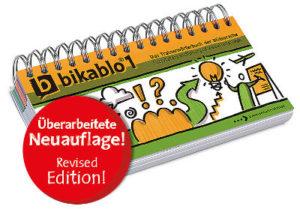

1st Bikablo Book
Bestselling original visual dictionary is a concise easy-to-use reference book that will guide you into the world of visual facilitation with hundreds of brilliant picture symbols. So it looks like this and you can still order it, and it’s still very valid because pictures don’t change so much. Like, you have a good dictionary in there. Right, and if you see that picture card pad, if we underline the first two letters here you would come up with a funny English term, it would be pi-ca-pa.
Okay, but the words in German they start with bild for pictures and cards we have karte and for pad we have the word block, which is similar to an English word.
So picture card block was actually here the first two letters, and that’s how the word bikablo® came up as the brand based on the first product they created. Right, but today bikablo® is much more than just this one visual dictionary.
Just recently we opened up the bikablo® academy, which is the worldwide head organisation for the bikablo® trainings. The bikablo® academy provides a training program which is quite different to many others.
We provide a very systematical approach to drawing. So you don’t need to draw a straight line to come to the training. We actually teach you how to hold the pen, how to draw a straight line without a ruler and just get this out of the pen. First thing in the morning we do together. All right. So let’s capture that.
We provide a systematical approach to drawing, and if you like, there is an early bird available and you can join in either in Sydney or Melbourne. There is London coming up and everywhere in the German-speaking areas as well.

The article was written by Natalia Tsygankova. Natalia has always loved words and talking to people. She has put that passion to good use and has been sharing people’s stories in the community radio, TV and print media for the last 10 years. Natalia is also a big fan of true storytelling events and regularly volunteers at the most famous one – The Moth, interviewing the winner. You can hear her own story of moving to Australia from Russia in 1999 here. Natalia believes that everyone has a story – So what’s yours? Contact her today to share your story.


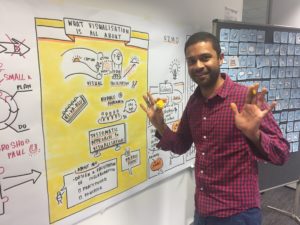
Facilitator, Educator, Designer, Coach / Co-author, Collaboration by Design
I think I have to confess something to you guys. April this year I recorded an amazing podcast with John Hibble about his venture, The Facilitation Starter. John Hibble is an experienced facilitator with more than 10 years in the field.
After I recorded this podcast in April my life became quite busy as I started building a house in May and had a newborn baby in July. That is the reason why this podcast stayed on my hard drive for quite a while. Now it’s time to unveil this great conversation about workshop preparation from the session designed over delivering a workshop to how you capture insights.
Over the last month, things have changed slightly. I’m very happy to announce that John is also now a certified bikablo® trainer like Martin and me, and together we run as the Visual Friends bikablo® training in Australia and New Zealand.
Now let’s do the time travel and go back to April and listen to John Hibble from the Visual Friends Team.

Marcel combines agile team coaching with visual thinking. Marcel believes that a group of people drawing together on a whiteboard can change the world. He loves high-performing teams and therefore coaches teams every day.

